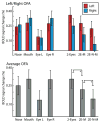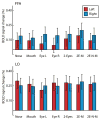The response of face-selective cortex with single face parts and part combinations
- PMID: 22750118
- PMCID: PMC3423083
- DOI: 10.1016/j.neuropsychologia.2012.06.016
The response of face-selective cortex with single face parts and part combinations
Abstract
A critical issue in object recognition research is how the parts of an object are analyzed by the visual system and combined into a perceptual whole. However, most of the previous research has examined how changes to object parts influence recognition of the whole, rather than recognition of the parts themselves. This is particularly true of the research on face recognition, and especially with questions related to the neural substrates. Here, we investigated patterns of BOLD fMRI brain activation with internal face parts (features) presented singly and in different combinations. A preference for single features over combinations was found in the occipital face area (OFA) as well as a preference for the two-eyes combination stimulus over other combination stimulus types. The fusiform face area (FFA) and lateral occipital cortex (LO) showed no preferences among the single feature and combination stimulus types. The results are consistent with a growing view that the OFA represents processes involved in early, feature-based analysis.
Copyright © 2012 Elsevier Ltd. All rights reserved.
Figures





Similar articles
-
Inversion effects in face-selective cortex with combinations of face parts.J Cogn Neurosci. 2013 Mar;25(3):455-64. doi: 10.1162/jocn_a_00312. Epub 2012 Oct 15. J Cogn Neurosci. 2013. PMID: 23066732 Free PMC article.
-
Consecutive TMS-fMRI reveals remote effects of neural noise to the "occipital face area".Brain Res. 2016 Nov 1;1650:134-141. doi: 10.1016/j.brainres.2016.08.043. Epub 2016 Aug 30. Brain Res. 2016. PMID: 27590719
-
Neuroanatomic correlates of the feature-salience hierarchy in face processing: an fMRI -adaptation study.Neuropsychologia. 2014 Jan;53:274-83. doi: 10.1016/j.neuropsychologia.2013.10.016. Epub 2013 Nov 1. Neuropsychologia. 2014. PMID: 24189157
-
Beyond the FFA: The role of the ventral anterior temporal lobes in face processing.Neuropsychologia. 2014 Aug;61:65-79. doi: 10.1016/j.neuropsychologia.2014.06.005. Epub 2014 Jun 14. Neuropsychologia. 2014. PMID: 24937188 Free PMC article. Review.
-
Visual recognition based on temporal cortex cells: viewer-centred processing of pattern configuration.Z Naturforsch C J Biosci. 1998 Jul-Aug;53(7-8):518-41. doi: 10.1515/znc-1998-7-807. Z Naturforsch C J Biosci. 1998. PMID: 9755511 Review.
Cited by
-
A neurocognitive model of perceptual decision-making on emotional signals.Hum Brain Mapp. 2020 Apr 15;41(6):1532-1556. doi: 10.1002/hbm.24893. Epub 2019 Dec 23. Hum Brain Mapp. 2020. PMID: 31868310 Free PMC article. Review.
-
How Negative Social Bias Affects Memory for Faces: An Electrical Neuroimaging Study.PLoS One. 2016 Sep 21;11(9):e0162671. doi: 10.1371/journal.pone.0162671. eCollection 2016. PLoS One. 2016. PMID: 27655327 Free PMC article.
-
Autism spectrum traits in normal individuals: a preliminary VBM analysis.Front Hum Neurosci. 2015 May 12;9:264. doi: 10.3389/fnhum.2015.00264. eCollection 2015. Front Hum Neurosci. 2015. PMID: 26029082 Free PMC article.
-
On the brain struggles to recognize basic facial emotions with face masks: an fMRI study.Front Psychol. 2024 Jan 26;15:1339592. doi: 10.3389/fpsyg.2024.1339592. eCollection 2024. Front Psychol. 2024. PMID: 38344280 Free PMC article.
-
A face is more than just the eyes, nose, and mouth: fMRI evidence that face-selective cortex represents external features.Neuroimage. 2019 Jan 1;184:90-100. doi: 10.1016/j.neuroimage.2018.09.027. Epub 2018 Sep 11. Neuroimage. 2019. PMID: 30217542 Free PMC article.
References
-
- Avidan G, Harel M, Hendler T, Ben-Bashat D, Zohary E, Malach R. Contrast sensitivity in human visual areas and its relationship to object recognition. Journal of Neurophysiology. 2002;87(6):3102–3116. - PubMed
-
- Betts LR, Wilson HR. Heterogeneous structure in face-selective human occipito-temporal cortex. Journal of Cognitive Neuroscience. 2010;22(10):2276–2288. - PubMed
-
- Brainard DH. The Psychophysics Toolbox. Spat Vis. 1997;10(4):433–436. - PubMed
Publication types
MeSH terms
Grants and funding
LinkOut - more resources
Full Text Sources
Medical

